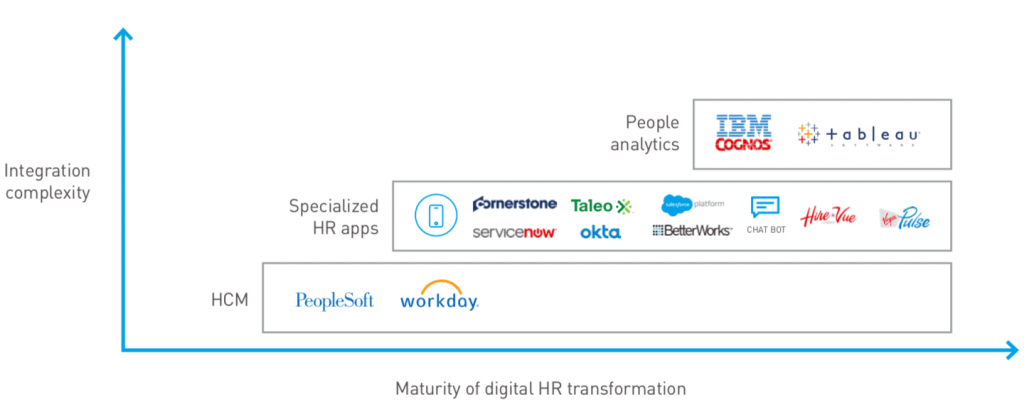Implementing new digital HR technology to attract and retain top talent is increasingly a top priority for many companies. But when the average HR department has more than nine systems of record that are not fully integrated, the quality of user experience suffers.
Common HR software in the employee lifecycle
The human capital resource (HCM) ecosystem encompasses technology to support the entire hire-to-retire employee lifecycle. The lifecycle is broken into five roles: recruitment, onboarding, development, retention, and separation. Data from each phase of the employee lifecycle can be integrated with platforms in other phases. Below are common technology projects throughout the employee lifecycle.

Integration across the entire employee lifecycle
Phase No. 1: Recruitment
- Supplementing HCM capabilities with best-of-breed applicant tracking system (ATS) and tools aimed at automating the hiring process.
- Implementing AI-powered chatbots that can help applicants with basic questions, integrated with ATS and HCM data to provide a personalized experience.
Phase No. 2: Onboarding
- Integrating new employee information (new or already existing within recruitment software/systems) with central HCM and other systems to sync up across the board.
- Providing personalized onboarding digital courses.
- Initializing employee accounts and access across platforms using identity and access management software.
Phase No. 3: Development
- Enabling employee productivity through personalized digital resources and courses.
- Integrating performance management software and real-time feedback tools with a central HCM.
- Using integrated digital learning platforms to help employees grow.
- Building integrated custom mobile apps focused on employee development.
Phase No. 4: Retention
- Integrating people analytics SaaS with central HCM, on-premise legacy systems, ATS, and other systems to preemptively take action against employee turnover.
- Adding personalized wellness applications to boost employee experience.
Phase No. 5: Offboarding
- Utilizing effective offboarding, removing employee information and access across all HR systems upon retirement using employee identity and access management, minimizing compliance risks.
- Auto-generating important offboarding documents such as 401(k), health care information, non-disclosure/non-compete documentation, taxes, and more.
- Automated updates to org charts.
- Inputting exit interview feedback to make improvements for other employees.
3 steps to get started
When you’re used to managing employee and hiring data in spreadsheets, the thought of creating a connected HR ecosystem can sound unrealistic. Rest assured that HR departments almost always implement their HR tech projects over time as they expand their digital HR capabilities and maturity. While every organization has a unique mix of HCM, HRM, ERP, SaaS, and ATS systems, there are three common steps that HR organizations take to building a fully-integrated ecosystem.

Step #1: Implement a cloud-based HCM solution
Integrate data from HR systems into a single Human Capital Management (HCM) software, like Workday, SAP SuccessFactors, or Oracle HCM Cloud.
Benefits: Unlocks existing on-premises employee data so it can be integrated across the HR ecosystem, removing the need for manual data entry.
Pro-tip: Step #1 often requires HR to make changes to modernize their legacy HR systems, such as on-premises payroll, benefits, or HRM systems. This can sound intimidating to already-slammed HR teams. But with the right integration strategy this upfront investment of time can shave days of manual data entry, spreadsheet calculations, and repetitive tasks off HR’s plate.
Step #2: Connect third-party cloud-based HR platforms and apps to supplement your HCM
Each HR organization has different needs, processes, and workflows, which require unique systems, data, and devices. By connecting applicant tracking software, performance management software, IT service management, identity and access management, and digital learning platforms to bolster the core HCM, HR can streamline data and processes — and capture data for deeper employee insights.
Benefits: Automate manual HR processes, such as hiring, payroll, and onboarding through apps and easily connect AI tools like chatbots and mobile apps.
Pro-tip: By connecting essential third-party apps and systems from the get-go, you can access and activate data from across the employee lifecycle to automate workflows and make smarter decisions.
Step #3: Establishing people analytics and predictive modeling capabilities
Establishing people analytics and predictive modeling enables HR management to make predictions and data-driven decisions about their workforce based on statistics collected on employees.
Benefits: People analytics and predictive modeling entails collecting data on employees in a way that allows for executives to make data-based decisions about their workforce. They also enable HR to automate processes such as hiring, payroll, recruiting, offboarding, and more. By automating manual processes, HR can be more productive, cost-efficient, and make data-driven decisions about hiring and employee workforce management to increase overall business productivity.
Pro-tip: These capabilities lay the groundwork for adoption of advanced technologies such as AI, advanced analytics, and robotic process automation. For example, using the insights generated by people analytics and predictive modeling, HR can adopt AI-powered chatbots to answer questions in hiring, onboarding, and benefits processes. Companies are also developing “recommendation engines” to identify learning pathways that might interest individual employees.
Read our 7 HCM integration best practices whitepaper for further insight into HR integration.









